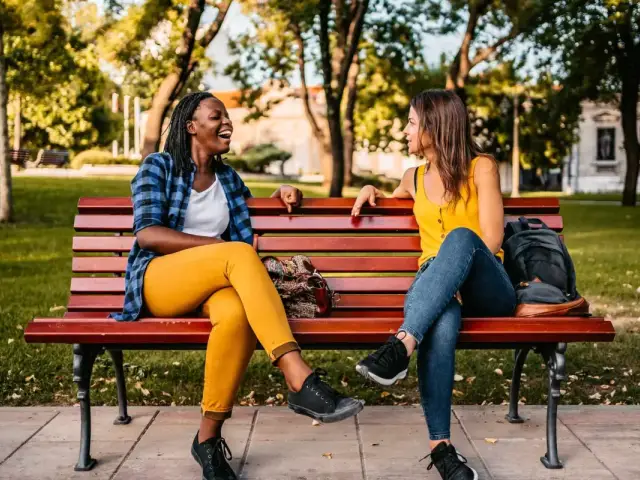It’s widely recognized that the crises of loneliness, disconnection, and social fragmentation are touching nearly every aspect of our lives, from personal well-being to public health to democracy itself. What’s far less clear is what to do about it.
Research helps us understand the scope of the problem, but for the average person or community leader, that insight often stops at diagnosis. Telling someone to “be less lonely” is about as helpful as telling them to “be less sick.” It doesn’t offer a path forward—and can even make the problem feel worse.
Across academic and professional disciplines, we’re offered different lenses and solutions. Urban planners emphasize walkable neighborhoods and shared spaces. Psychologists highlight the value of close relationships and emotional support. Civic leaders encourage volunteering and bridging divides. Economists point to the role of connection in mobility and opportunity.
X

Each offers a valuable piece of the puzzle, but for those trying to build a socially connected life in their own communities, the guidance can feel fragmented, idealistic, and often overwhelming. We are, ironically, disconnected in how we talk about disconnection.
At the U.S. Chamber of Connection, a nonprofit focused on building the civic infrastructure of connection, we wanted to answer a simple but pressing question: What does it actually mean to live a connected life—and how can we help more people do it?
Drawing from a wide body of research across psychology, public health, sociology, urban design, and behavioral science, we surfaced six core domains that consistently showed up as key to personal and societal thriving. We call them the Six Points of Connection.
These six points are not abstract ideals. They’re concrete, actionable behaviors that can be practiced by anyone, anywhere. Each one is backed by evidence that links it to better health outcomes, stronger civic trust, and greater resilience in the face of stress and change.
The model is designed to be intuitive and accessible. Individuals can use it as a self-check—where am I strong, and where could I grow? Community organizations can use it to design programs that meet people where they are. City leaders can use it to measure and support neighborhood cohesion. The goal isn’t perfection; it’s intentionality. By shifting our focus from abstract goals like “belonging” to clear steps we can take, we center social connection as something we can build—step by step, relationship by relationship.
Connection isn’t just something we long for—it’s something we can design for. And in doing so, we don’t just improve individual lives. We strengthen the foundation of a healthier, more compassionate society.
1. Have a neighborhood emergency contact
Research published by the Pew Research Center and others shows that almost one-third of Americans don’t know a single neighbor, and nearly half never interact with those living nearby. But knowing our neighbors is an important part of our experience of being home and feeling “at home.” Feeling surrounded by people we know makes us feel safer, which in turn makes us more secure and measurably healthier. Existing research clearly supports our intuition.
From a community perspective, strong neighbor networks yield numerous benefits. Connected neighborhoods have lower crime rates; through collective vigilance, they enhance disaster readiness, and retain local memory and cohesion. In low-income neighborhoods especially, neighbor-based support can replace paid services—like pet sitting or child care—helping residents bridge resource gaps while enriching social capital for the whole neighborhood.
Practically, building connections can be surprisingly straightforward. Initiatives like “front porch chats,” block parties, or community social media groups foster casual interactions. Neighbors might exchange contact info, designate mutual pet care backups, or simply commit to checking in regularly. Local governments can promote neighborhood-led events, support local community councils, nurture organizations that demonstrate a commitment to fostering local community connections, and recognize local “ambassadors” on every block.
If all that sounds ambitious, you can take a first, simple step by finding a neighborhood emergency contact—and suggesting they do the same. That chain of connection can become the foundation of something more.
2. Belong to a community of identity
Belonging to a community with a shared identity is one of the most effective ways to foster deep, meaningful connections. People feel most comfortable, understood, and supported in groups where they share core aspects of their identity, such as ethnicity, culture, gender, or experiences. A shared identity fosters deeper trust, emotional safety, and, crucially, a deep sense of belonging.
Copious research demonstrates that being an active participant in a community of identity not only contributes to a healthy mental state, but it also provides resiliency and a protective effect when adversity strikes, thus decreasing the likelihood of anxiety and depression. We are by nature a social animal and being part of a group provides the sense of belonging we need, as we need food and shelter, for our very survival.
Communities form around cultural associations such as lesbian, gay, bisexual, transgender, and queer (LGBTQ+) networks, faith groups, professional affinity groups, or alumni chapters. People connect through shared narratives and experiences. Simply witnessing others who “look like me, live like me” and share values creates a profound sense of emotional connection. A civil society is a web of these groups that support their members but also ideally bridge people across differences.
Importantly, passive affiliation isn’t enough. To gain the belonging benefits, individuals must actively engage: attend events, volunteer, share stories—investing reciprocity. Those without such connections are more vulnerable to loneliness and dissatisfaction. In communities where loneliness and isolation are common, there is more crime, neglect, poverty, and addiction.
Given America’s increasingly diverse tapestry, identity communities provide vital emotional grounding and the fertile ground for the formation of purpose, meaning, resiliency, and overall life satisfaction. For newcomers or marginalized individuals especially, finding their group is a lifeline—essential not only for individual well-being, confidence, and social trust but also for the health of our whole community.
Belonging to a community of identity emerged as the second of the Six Points of Connection because of the volumes of data on its importance—and also because it is perhaps the most difficult of the six to achieve if you lack it.
For individuals seeking “their people,” understanding the importance of an identity group is an important first step. Local governments and civic organizations can start by understanding the needs and capacity of existing groups—and then play a bridging role by linking people in need to existing groups during life transitions.
3. Join an activity-based community
Activity-based communities gather around shared interests or hobbies such as sports, crafts, or volunteering opportunities.
Unlike identity communities, connection in an activity group is through doing something together rather than being centered around identity. Such groups satisfy the human longing for shared purpose: We aren’t just friends, we’re teammates, gardeners, dancers. A sense of collective accomplishment fosters belonging, trust, and self-confidence.
These environments can be especially good at bridging social divides. These groups offer rich opportunities to foster shared purpose, mutual support, and regular contact across social differences. Empirical studies show that social ties promote civic and even physical engagement. For example, people in exercise groups meet health guidelines at 40% higher rates than isolated individuals.
Communities benefit, as well: Activity groups support local culture, enrich civic life, and spark volunteer and leadership opportunities. Churches, nonprofits, sports leagues, and libraries often host these groups—providing ready platforms for civic actors to connect newcomers to shared recreation and learning.
Employers wishing to nurture connection can support intramural teams, trivia nights, or book clubs, or simply provide space and time for organically arising activity groups. Local governments and civic organizations seeking to improve social connectedness can nurture local teams and clubs with space to play or meet—and they can offer recognition to local community-builders who foster activity groups in their area.
4. Connect with a friend or family member at least twice a week
Regular, heartfelt conversations with people outside of work or home are fundamental to mental and Emotional resilience. On this front, quality means more than the quantity of interactions.
Mutually engaged, empathic exchanges foster support and meaning in life. Research consistently shows that individuals with frequent contact with friends or family report better Mental health, lower stress, and stronger coping skills. These regular ties reduce the sense of isolation and enhance feelings of stability and belonging.
Practically, this can be as simple as arranging a weekly coffee date with a friend, a nightly call with a loved one, or a regular shared meal. The key is building the habit: Schedule it, communicate its importance, and treat it like any essential commitment. While online interactions aren’t as beneficial as in-person ones, they’re still better than nothing, especially with undivided attention, engagement, and the ability to experience the other’s emotions in real time.
Modern life—work stress, remote living, shifting time zones—can disrupt regular contact. Local governments, civic organizations, and employers can support this through “connection hours,” buddy systems, or digital platforms that encourage check-ins and community among coworkers, neighbors, and friends. Having a rhythm of connection helps prevent drift. It creates an emotional rhythm—a safety valve for stress, a space for celebration, and a foundation for collective trust.
5. Finding your third place in the community
Coined by sociologist Ray Oldenburg in 1999, the “third place” is neither home (first place) nor work (second place), but a social environment fostering casual, egalitarian interaction, such as cafés, libraries, barber shops, parks, gyms, or community centers. Third places are ideal environments to further bonding, offering a relaxed space for both casual conversations and meaningful connections.
In our research, we have found that third places are ideal for creating opportunities to create “bridging social capital,” which refers to connections made between people from different backgrounds. Bridging social capital fosters the formation of diverse and supportive social networks that offer resiliency and have been shown to improve Mental health and lower stress levels.
This may mean finding a weekly trivia night, a community center class, a church group—or simply being a regular at the corner café. It’s about creating a home base beyond work or living rooms, where casual friendships form through shared routines.
For local governments, employers, or civic organizations, investing in public space, walkable streets, cultural hubs, and welcoming venues supports third places organically. For individuals, it serves as an invitation for people needing connection to explore spaces in their neighborhood and encourages their sense of comfort and belonging in places outside their home.
6. Volunteering in the community
Engaging in community service through volunteering, mutual aid, or civic organizations strengthens personal well-being and supports the broader community. Volunteering is a powerful act that bridges community needs and personal agency.
A study by the University of Maryland found that when people volunteer, they are 24.4% more likely to join a community group, and people who volunteer are less likely to be lonely. Thus, volunteering both reflects and reinforces connection to create a virtuous cycle of engagement.
Importantly, civic volunteers gain new networks, leadership skills, and a grounded sense of impact, which is especially important for newcomers who lack established local ties. Volunteering builds a shared vocabulary of civic responsibility, mutual trust, and cross-cultural collaboration. For communities, volunteerism fills critical social service gaps, strengthens nonprofits, and fosters intergenerational solidarity.
In volunteering, we feel stronger ties, trust, responsibility, and accountability to our community; we are truly bridged into a resilient, diverse community. Local governments, employers, and civic organizations can foster this by integrating volunteering into newcomer onboarding, public school curricula, and neighborhood events so that the act of service becomes part of the collective expectation, not just a feel-good afterthought.
The “Six Points of Connection” framework is a practical roadmap, rooted in evidence, with each point building on the next. First safety is assured, then bonding, and finally bridging. Whether through a conversation over the garden fence, a church service, a friend’s weekly call, a community garden, or teaching a language learner in your local library, each point changes the world—one intentional choice at a time.












